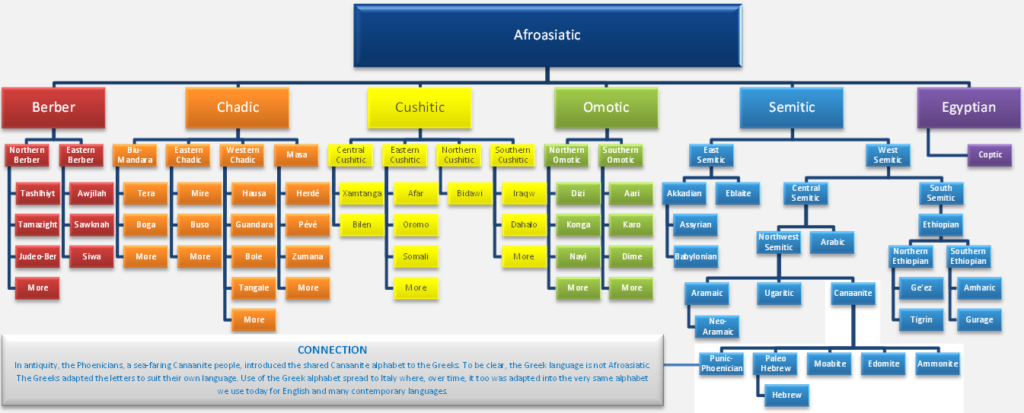
The Language Tree
Once upon a time there was Afroasiatic—a language and culture that gave rise to many other languages and cultures—including Hebrew.
Scientists have surmised the existence of Afroasiatic based on their analyses and comparisons of other languages. Use the following language tree to see how Hebrew (in light blue) evolved from Afroasiatic (in navy). Work your way down the Semitic language branch (in light blue) to find Paleo Hebrew and its sister Canaanite languages.
Relational Depiction of Languages
Can you locate Hebrew and other familiar languages in this chart?

What’s in a Name?
Afroasiatic
The name refers not to the language’s point of origin (which we do not know), but to where those who speak Afroasiatic’s many daughter languages reside today—Africa and Asia. We do not believe that Afroasiatic was written and, therefore, we have no way to learn its true name. In the 19th century, the name Afroasiatic was designated.
Semitic
In the 18th century, the name Semitic was designated by a group of now discredited pseudoscientists at the Göttingen School of History in Germany. To give you an idea of how out of touch they were by today’s standards, it was at this very school that the term Caucasian was first used to describe a race of white people.
The name Semitic was chosen to represent the descendants of Abraham, as well as the cultures and languages they speak. Semitic means relating to Sem, a character in the Torah: a son of Noah and a direct ancestor of Abraham.
Today, the term Semitic is used to describe languages. Semitic does not properly refer to any group of people living today—not even a group that speaks a Semitic language, such as Hebrew, Arabic, Maltese, or one of the many languages of Ethiopia.
Antisemitic
In his protest and challenge of the now discredited racist theories regarding “Semitic peoples,” Moritz Steinschneider coined the term antisemitic (he wrote in German: antisemitische Vorurteile – “antisemitic prejudices”). The term antisemitic is still in use today, and identifies anti-Jewish prejudice in particular.
Below are Jonah Cohen, PhD’s tips to help you respond effectively when confronted by antisemitic remarks:
- Ask them: What do you mean by that?
- Ask them: What are your reasons for thinking that’s true?
- Ask yourself: Is their story possible, plausible, or probable given the evidence and competing theories?
- Ask them leading/elenetic questions, such as:
- How does what you say square with this other important fact?
- At what cost? Wouldn’t your proposal result in bad outcomes, such as …?
- Compared to what?
- Wouldn’t you agree that such-and-such is true? Then how come you say so-and-so is also true?